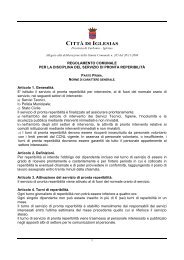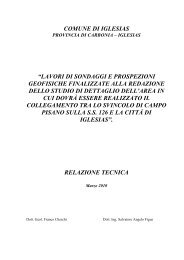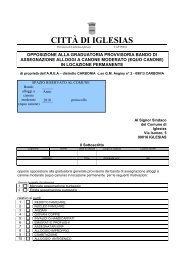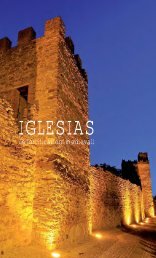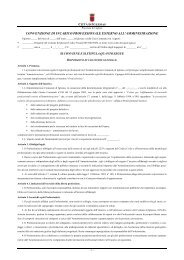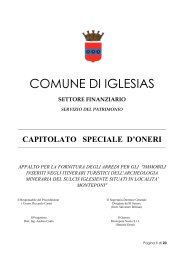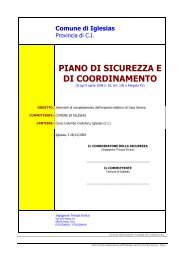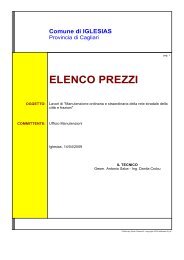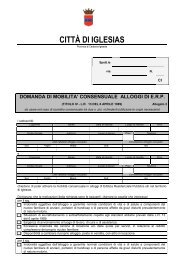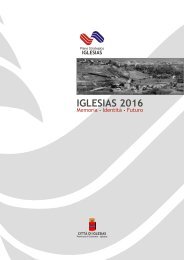Architetture religiose e arte sacra - Comune di Iglesias
Architetture religiose e arte sacra - Comune di Iglesias
Architetture religiose e arte sacra - Comune di Iglesias
Create successful ePaper yourself
Turn your PDF publications into a flip-book with our unique Google optimized e-Paper software.
Il retablo del Mainas<br />
l polittico, tempera su tavola (cm<br />
335 x 242), attribuito ad Antioco<br />
I6<br />
Mainas (1537-1571) è formato da<br />
scomparti, <strong>di</strong>visi da cornici<br />
intagliate e dorate, <strong>di</strong>sposti su due<br />
or<strong>di</strong>ni e poggia su una predella<br />
sud<strong>di</strong>visa a sua volta in cinque<br />
riquadri. Nello scomparto<br />
principale in basso l'Annunziata e<br />
in alto il Crocifisso tra la Madonna<br />
e san Giovanni. In quello <strong>di</strong> destra,<br />
l'Adorazione dei pastori in basso e<br />
sant'Orsola fra le vergini in alto. In<br />
quello <strong>di</strong> sinistra l'Adorazione dei<br />
magi in basso e santo Stefano<br />
lapidato in alto. La predella<br />
presenta nel riquadro centrale la<br />
Resurrezione <strong>di</strong> Gesù; nel primo<br />
riquadro a destra i santi Pietro e<br />
Accursio, i santi Bernardo ed<br />
A<strong>di</strong>uto nel secondo. A sinistra i<br />
santi Ottone e Francesco d'Assisi e<br />
nello scomparto esterno Bernar<strong>di</strong>no<br />
<strong>di</strong> Siena e Antonio <strong>di</strong> Padova.<br />
L'opera si inscrive nell'ambito della<br />
produzione artistica della bottega<br />
cagliaritana <strong>di</strong> Stampace (dal nome<br />
dell'omonimo quartiere <strong>di</strong> Cagliari<br />
in cui aveva sede) e si definisce per<br />
un carattere stilistico dai toni<br />
popolari e narrativi. In questa stessa<br />
cappella sono inoltre conservate tre<br />
campane provenienti dal <strong>di</strong>strutto<br />
campanile. Si tratta <strong>di</strong> tre bronzi<br />
realizzati tra la fine del secolo XVI e<br />
la seconda metà del secolo XVII.<br />
Mainas's retable<br />
The polyptych (tempera on canvas, 335 x<br />
242 cm) attributed to Antioco Mainas<br />
(1537-1571), consists of 6 compartments<br />
<strong>di</strong>vided by carved, gilt frames, arranged on two orders and supported by a predella <strong>di</strong>vided into 5<br />
panels. The main panel (lower sect.) illustrates the Annunciation; above is a painting of the Crucifix<br />
between the Virgin and Saint John. The right p. shows shepherds' Adoration (lower sect.) and St.<br />
Orsola among the virgins (up. sect.). The left p. describes the three Kings' Adoration (lower sect.)<br />
st<br />
and St. Stephen's martyrdom (up. sect.). In the central p., on the predella, a Resurrection; the 1 p.<br />
nd<br />
on the right portrays St. Peter and Accursio, while in the 2 p. are St. Bernard and A<strong>di</strong>uto. On the<br />
left, St. Ottone and St. Francis of Assisi. The external compartments feature Saints Bernar<strong>di</strong>no of<br />
Siena and Anthony of Padua. This work refers to the artistic production of the Stampace shop<br />
(after the name of the homonymous qu<strong>arte</strong>r of Cagliari), marked by a popular, narrative style.<br />
th th<br />
The same chapel guards 3 bronze bells of 16 -17 C. recuperated from the destroyed bell tower.<br />
27



